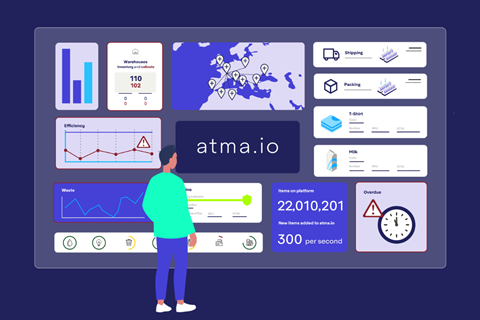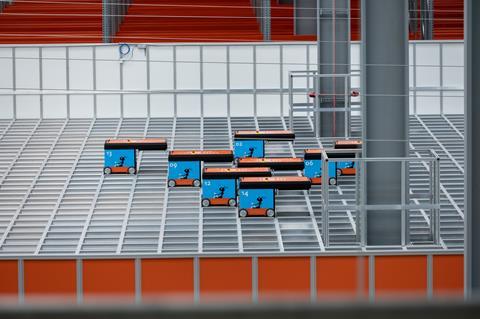
Advances in AI (Artificial Intelligence) have made headlines and sparked both excitement and concern - but what are its roles and applications in the packaging industry? Frances Butler reports.
AI (Artificial Intelligence) is currently being applied in the packaging industry in ways including predictive maintenance; packaging design (such as creating multiple variations of each design); and preventing downtime for machinery. The Data Scientist elaborated on this, also drawing attention to augmented and virtual reality experiences for consumers and AI-assisted product sizing.
What does the future of AI in packaging look like? In April this year vice president of client service (UK/IE/AUS) for Equator Design Adam Sears spoke to us on this topic. He highlighted the importance of understanding consumer motivations and the ability to collect data which can be used by businesses to build models and further understand audience behaviour. Machine Learning (ML), a subset of AI, can identify patterns in data and ‘learn’ from them to make improvements.
Sears also pointed out the potential of using past data to predict future events, such as gathering consumer data through mobile apps and using it to hone marketing strategies. He added it can also improve sustainability efforts, as businesses can monitor and track products throughout the supply chain.
Focus on production and logistics
How is AI being used in packaging within the production and logistics sectors? Food processing and packaging solutions provider Tetra Pak published a whitepaper on Industry 4.0 (the trend of automation and data exchange in manufacturing technologies, including AI) suggesting ways for companies to increase productivity in food and beverage industry.
One example given in the whitepaper is the connection and integration of equipment at customer plants, enabling machines to communicate with each other and synchronise themselves. Companies can keep track of orders throughout the supply chain, meaning logistics timeframes can be shortened. Machine learning algorithms are also highlighted – the algorithm can ‘learn’ and adapt its outputs based on new information, which can help to predict and solve complex problems. Tetra Pak says algorithms can also use information gathered to number crunch and predict ‘optimum plant operation’.
Keeping track
In the adhesive materials industry, Avery Dennison recently announced updates to its atma.io connected product cloud, incorporating AI features such as ChatGPT. Businesses can use the cloud to track, store and manage events associated with individual products through the unique digital IDs assigned to them. We spoke to vice president of digital solutions Max Winograd to learn more.
Reportedly, atma.io provides firms with an overview of open issues for each supplier through ‘callout’ notifications. When a ‘callout’ needs actioning, logistics personnel find the affected supplier’s email, gather the information about the issue and compose and send the email. Winograd explained:
“With AI-generated email templates, logistics personnel won’t need to write a message, the AI will do it for them. They’ll just need to read through it, customise it, and hit send.”
AI and ML can detect anomalies in the supply chain more efficiently and effectively than human oversight, Winograd said. When keeping track of compliance certifications, automating compliance processes or evaluating materials bills, having “item-level data” managed across the supply chain and business means data is “readily available to tools that leverage AI or ML” and can be turned into actionable insights.
In contrast, he added “the outputs are only as good as the inputs”, meaning the data being analysed and acted upon may not always be accurate “because the integrity of the data is not 100%”.
Avery Dennison also incorporates RFID (Radio-Frequency Identification) labels in the e-commerce and logistics areas. Winograd states:
“The combination of RFID and AI/ML within our applications enables pre-emptive and proactive alerts and actions based on inventory, supply chain, and product data, efficient e-commerce capabilities and increases the velocity of products from factory to consumer.”

A challenging environment
In 2019, an article by McKinsey described automation in logistics as “big opportunity, bigger uncertainty”. The authors outlined 5 reasons for companies’ hesitation to automate: “the unusual competitive dynamics of e-commerce, a lack of clarity about which technologies will triumph, problems obtaining the new gizmos, uncertainties arising from shippers’ new omnichannel-distribution schemes, and an asymmetry between the length of contracts with shippers and the much-longer lifetimes of automation equipment and distribution centres.”
On the other hand, automation can assist with worker shortages, rising online sales and technological advances, the authors stated. They added that logistics companies are “intrigued by the potential of automation but wary of the risks” with McKinsey research estimating “investment in warehouse automation will grow the slowest in logistics, at about 3 to 5 percent per year to 2025.”
The authors said e-commerce companies’ buying power, companies such as Amazon having their own logistics capabilities and the “very spiky” demand for e-commerce is worth considering.
Humans and robots working together
However, one company implementing automation and AI in logistics is Active Ants, an e-fulfilment company with “automated end-to-end warehouse processes”. Both humans and robots cover logistics for online stores from receipt and storage to packaging and shipping to end customers. We spoke to Khalil Ashong, county director at Active Ants UK, to find out more.
Automation is an opportunity to engineer processes to be as efficient as possible and process “consistently large volumes of parcels through the warehouse without much reliance on human labour, which can be unreliable,” Ashong said. He added robots and automation will “do things the way you have designed them to do it, over and over again, until you change your instruction to them.”
There are challenges involved in having humans and robots working side-by-side. According to Ashong, it’s important to remember the company’s robots and automation is handled by humans. “The biggest challenge is getting our human colleagues to understand what the robots are there to do and making it clear to our human colleagues what they need to do in assisting the robots.”

On the developments AI could bring to the packaging industry, Ashong thinks AI can help with packaging efficiency and waste reduction. He expanded on this:
“If you know what you are packing and how much it weighs, you are not going to make a box that will have a lot of surplus air in it or a box that needs lots of void fill. The more information you have about your packing process the more efficient it becomes, because you are learning about past orders and using that information to shape your approach to future orders.”
Active Ants’ AutoStore warehouse storage solution apparently takes up 6 times less space than in a traditional warehouse. Ashong said the system works on density, with items usually only stored in their master cartons when on pallets. The bins are stacked 16 high in columns and accessed from the top on an aluminium grid.
The company uses AI to monitor and track products through the supply chain. Ashong believes this information can help better understand clients. He explained:
“If a client is shipping two or three of the same pair of shorts from three different locations, we have that information and we can help them to streamline and ship from just one location.”
“Through our handling of a product we can tell how many times a client has shipped to a particular part of the country, what they ship to that location and feed it back to them, so they can improve their processes and products.”
When asked about the future developments and implementation of AI, Ashong concluded that “logistics is about doing the same things repeatedly in the most cost-effective way. For repetitive and mundane tasks, robots and machines are always going to be available so we need to assign those tasks accordingly and elevate the humans from doing repetitive tasks to more skilled roles.”
It is difficult to predict how the working dynamic between humans and robots will develop in future as there are fears around AI replacing human jobs – however, as Ashong has illustrated, it is possible for both to be involved in warehouse operation side-by-side.
Overall, it seems that while there are concerns around the use of AI in logistics and production (such as the use of robots and also in e-commerce due to uncertainty around demand) there is potential for companies to implement AI to monitor and increase efficiency; apply changes to marketing strategies and packaging design from collected data; and use this data to predict future packaging needs and consumer behaviour.
If you liked this article, you might also enjoy:
The L’Oréal approach to packaging sustainability
What steps is Apple taking to make its packaging more sustainable?
How did Brazil achieve its 100% aluminium can recycling rate – and can it be replicated in the EU?
Experts have their say on the EU’s Packaging and Packaging Waste Directive revisions

















No comments yet